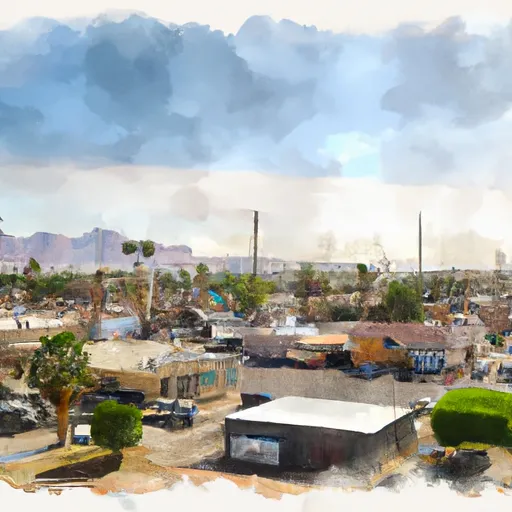-
 Snoflo Premium
Snoflo Premium
Get unlimited access to all our content
With no Ad interruptions! - Start Your Free Trial Login with existing account
Yuma-Proving-Gro
Eden Index
Climate
6.7
•
Recreation
4.3
•
Community
2.9
•
Safeguard
4.9/10

Yuma Proving Ground (YPG) is a United States Army installation located in southwestern Arizona, near the city of Yuma. The region is characterized by a hot desert climate with long, extremely hot summers and mild winters. YPG experiences scorching temperatures in the summer, often exceeding 100°F (38°C), while winter temperatures range from 60-70°F (15-21°C). The area receives minimal rainfall, typically less than 3 inches per year.
Hydrologically, YPG lies within the Colorado River Basin and is surrounded by the Sonoran Desert. The Colorado River provides water for irrigation and supports diverse flora and fauna. The region's hydrology is significant for the area's agricultural activities and the unique ecosystems it sustains.
Outdoor recreation opportunities in Yuma-Proving-Ground are abundant. The picturesque landscapes encompassing the proving ground offer opportunities for hiking, camping, and birdwatching. The nearby Colorado River provides options for boating, fishing, and kayaking. Additionally, YPG allows limited public access to designated areas for hunting and off-road vehicle use, contributing to the area's recreational appeal. Whether exploring the desert's unique ecosystems or enjoying outdoor activities on the river, YPG and its surroundings offer a diverse range of experiences for outdoor enthusiasts.
What is the Eden Index?
The Snoflo Eden Index serves as a comprehensive rating system for regions, evaluating their desirability through a holistic assessment of climate health, outdoor recreation opportunities, and natural disaster risk, acknowledging the profound impact of these factors on livability and well-being.
Climate Health Indicator (CHI): 6.7
Yuma-Proving-Gro receives approximately
98mm of rain per year,
with humidity levels near 46%
and air temperatures averaging around
24°C.
Yuma-Proving-Gro has a plant hardyness factor of
10, meaning
plants and agriculture in this region tend to thrive here all year round.
By considering the ideal temperature range, reliable water supplies, clean air, and stable seasonal rain or snowpacks, the Climate Health Indicator (CHI) underscores the significance of a healthy climate as the foundation for quality living.
A healthy climate is paramount for ensuring a high quality of life and livability in a region, fostering both physical well-being and environmental harmony. This can be characterized by ideal temperatures, reliable access to water supplies, clean air, and consistent seasonal rain or snowpacks.
Weather Forecast
Streamflow Conditions
Lower Gila
Area Rivers
Lower Gila
Snowpack Depths
Lower Gila
Reservoir Storage Capacity
Lower Gila
Groundwater Levels
Recreational Opportunity Index (ROI): 4.3
The Recreational Opportunity Index (ROI) recognizes the value of outdoor recreational options, such as parks, hiking trails, camping sites, and fishing spots, while acknowledging that climate plays a pivotal role in ensuring the comfort and consistency of these experiences.
Access to outdoor recreational opportunities, encompassing activities such as parks, hiking, camping, and fishing, is crucial for overall well-being, and the climate plays a pivotal role in enabling and enhancing these experiences, ensuring that individuals can engage in nature-based activities comfortably and consistently.
Camping Areas
| Campground | Campsites | Reservations | Toilets | Showers | Elevation |
|---|---|---|---|---|---|
| Desert Breeze Military - Yuma PG | None | 195 ft | |||
| Imperial Dam LTVA Dispersed | None | 162 ft | |||
| Squaw Lake | 125 | 183 ft | |||
| Picacho State Rec Area | 58 | 265 ft | |||
| Imperial Dam Long Term | None | 282 ft | |||
| Yuma VFW | None | 169 ft | |||
| Fortuna Pond Dispersed | None | 154 ft | |||
| Lake Martinez Military | None | 196 ft | |||
| Mittry Lake Dispersed | None | 183 ft |
Nearby Fishing
Nearby Ski Areas
Catastrophe Safeguard Index (CSI):
The Catastrophe Safeguard Index (CSI) recognizes that natural disaster risk, encompassing floods, fires, hurricanes, and tornadoes, can drastically affect safety and the overall appeal of an area.
The level of natural disaster risk in a region significantly affects safety and the overall livability, with climate change amplifying these risks by potentially increasing the frequency and intensity of events like floods, fires, hurricanes, and tornadoes, thereby posing substantial challenges to community resilience and well-being.
Community Resilience Indicator (CRI): 2.9
The Community Resilience Indicator (CRI) recognizes that education, healthcare, and socioeconomics are crucial to the well-being of a region. The CRI acknowledges the profound impact of these elements on residents' overall quality of life. By evaluating educational resources, healthcare accessibility, and economic inclusivity, the index captures the essential aspects that contribute to a thriving community, fostering resident satisfaction, equity, and social cohesion.

